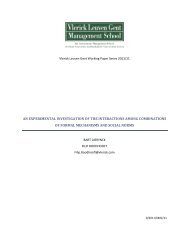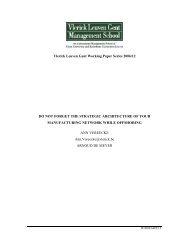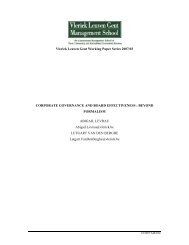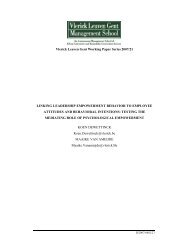innovation and internationalization by indian firms - Vlerick Public
innovation and internationalization by indian firms - Vlerick Public
innovation and internationalization by indian firms - Vlerick Public
You also want an ePaper? Increase the reach of your titles
YUMPU automatically turns print PDFs into web optimized ePapers that Google loves.
developed countries that lack experience of operating in these institutional settings (Khanna <strong>and</strong><br />
Palepu, 2006).<br />
Thus emerging market <strong>firms</strong> that have learned to compete in institutional environments<br />
characterized <strong>by</strong> weak institutions <strong>and</strong> institutional voids may be better positioned to compete in<br />
other emerging markets with similar environments. This logic underlies the concept of institutional<br />
arbitrage. Hall <strong>and</strong> Soskice (2001) define institutional arbitrage as follows: ‘multinational enterprises<br />
may shift particular activities to other nations in order to secure the advantages that the institutional<br />
frameworks of their political economies offer for pursuing those activities’ (2001:57). Thus gaps in<br />
the host institutional environment or an unfavourable institutional environment may be offset <strong>by</strong><br />
taking advantage of institutional arbitrage. In summary, institutional theory concepts suggest that<br />
emerging market <strong>firms</strong> may benefit from engaging in institutional arbitrage in other emerging<br />
markets (Figure 1).<br />
In addition, industry conditions in many of the still ‘emerging’ <strong>and</strong> mostly ‘transitional’<br />
markets were also evolving in the 1990s. In many emerging markets, industry structures were less<br />
well developed <strong>and</strong> less competitive than in developed markets. For instance, supplier networks <strong>and</strong><br />
related industry infrastructure were less well-developed. Product <strong>innovation</strong> was less aggressively<br />
practiced, <strong>and</strong> incumbents tended to coexist in terms of sharing the overall market. At the extreme,<br />
entire industries or important segments of industries were undeveloped. In other cases, industries<br />
had homogenous product offerings, with little segmentation or differentiation to address the unique<br />
dem<strong>and</strong>s of customer sub-segments.<br />
In such a context, <strong>firms</strong> from other emerging markets that have relatively advanced<br />
domestic markets in terms of product <strong>innovation</strong> <strong>and</strong> competitive intensity were likely to find such<br />
underdeveloped markets <strong>and</strong> industries attractive for entry. These <strong>firms</strong> could bring assets that they<br />
have developed in their domestic markets, <strong>and</strong> that had value, i.e. fit, in specific emerging or<br />
developing economies. These assets <strong>and</strong> capabilities could be unique, in the sense that Western<br />
competitors may not have the same accumulated set of relevant capabilities. Thus, penetration of<br />
particular segments was potentially easier. Figure 1 reflects this idea that emerging market <strong>firms</strong><br />
may find attractive opportunities under specific institutional <strong>and</strong> industry conditions.<br />
For Indian <strong>firms</strong>, relative success in addressing such new dem<strong>and</strong>s in the 1990s was to a<br />
large extent based on their use <strong>and</strong> leveraging of various kinds of <strong>innovation</strong>. Some of these were<br />
product-based, mostly in low-end consumer goods, garments, <strong>and</strong> medicines, namely the four T’s:<br />
tea, toothpaste, t-shirts, <strong>and</strong> tablets. A major rationale for such <strong>innovation</strong>s were those based on<br />
exploiting factor differentials, in terms of both cost <strong>and</strong> quality, between India <strong>and</strong> the host markets.<br />
Other types of product based <strong>innovation</strong>s were also seen on a limited scale. For instance,<br />
6










